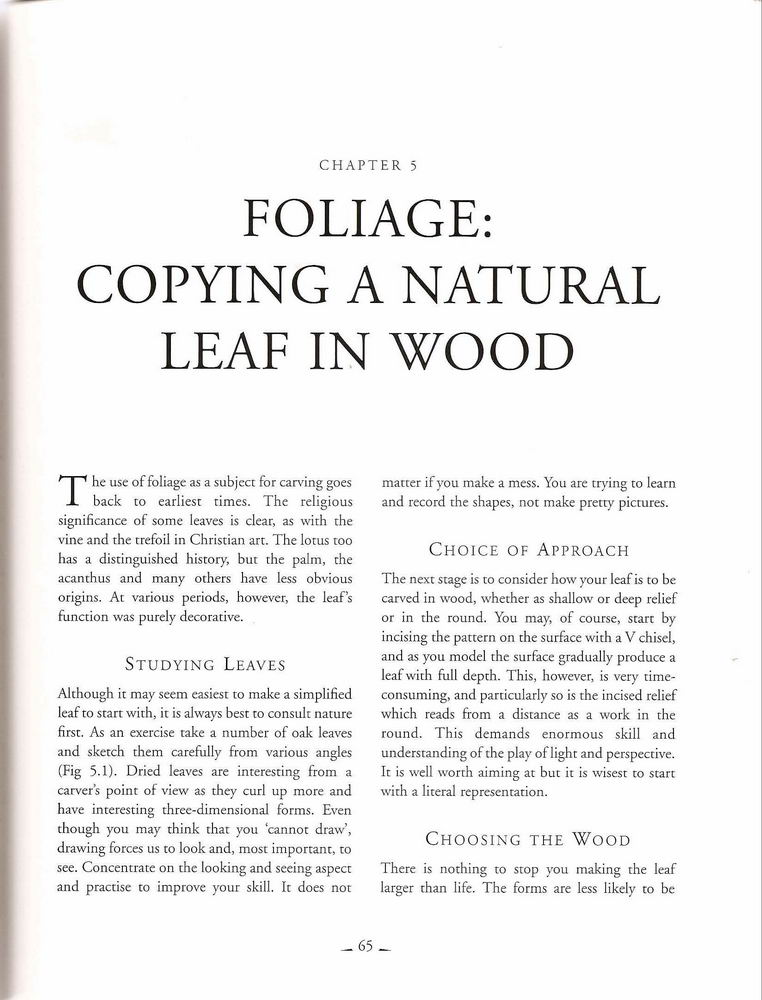essentÊrving°65

CHAPTER 5
FOLIAGE:
COPYING A NATURAL LEAF IN WOOD
The usc of foliage as a subjcct for carving goes back to earliest times. The religious significance of somc Ieaves is elear, as with the vine and the trefoil in Christian art. The lotus too has a distinguished history, but the palm, the acanthus and many others have less obvious origins. At various periods, however, the leaf s function was purely decorative.
Studying Leaves
Although it may seem casicst to make a simplified leaf to start with, it is always best to consult naturę first. As an exercise takc a number of oak leaves and skctch them carefully from various angles (Fig 5.1). Dried leaves are interesting from a carvers point of view as they curl up morę and have interesting thrcc-dimensional forms. Even though you may think that you ‘cannot draw’, drawing forces us to look and, most important, to see. Concentrate on the looking and seeing aspect and practisc to improve your skill. It does not matter if you make a mess. You are trying to learn and rccord the shapes, not make pretty pictures.
Choice of Approach
The next siage is to consider how your leaf is to be carved in wood, whether as shallow or deep relief or in the round. You may, of course, start by incising the pattern on the surface with a V chisel, and as you model the surface gradually produce a leaf with fuli depth. This, however, is very time-consuming, and particularly so is the incised relief which reads from a distance as a work in the round. This demands enormous skill and understandingof the play oflight and perspective. It is well worth aiming at buc it is wisest to start with a literał represenration.
Choosing the Wood
There is nothing to stop you making the leaf larger rhan life. The forms are less likely to be
— 65 ^
Wyszukiwarka
Podobne podstrony:
essent?rving?69 F O I. I A G F. : COPYING A NATURAL LEAF IN W O O D Fic; 5.7 Thegr
CCF20110611�059 Criterion-Referenced Test: A test in Which the performance of an individual is
As the blood thatflows through our bodies is staunched, goes back to the earth, so I bind
essent?rving?71 F O L I A G E : COPYING A NATURAL L E A F IN W O O D ignore. The carver of this oak
324 GkeatBasin NaturalistMemoirsNo. 11 __ 1962. On the role of tlie symbionts in wood-de- stroying i
Now in paperback!The voice of the futurÄ™ irwites you to the new millennium...WILLIAMGIBSON Ali Tomor
21 In principle the agglomeration of the nomands is not large, it counts some twenty to eighty perso
No tfrróng when aincerc cin cvtr bc in vjk. The molo of our effom might again bc taken up and c
2 7 The negotiator in tlie hard style; - Demands concessions as a condition for ma
18 Małgorzata Bednarczyk, Ewa Wszendybył-Skulska According to the model presented in Figurę 2, the e
htdctmw 075 Keep these drawings which depict the skuli in different angles, and use them as guides f
- 3 - million ha in 1985* The overexploitation of the vegetative cover caused by human and animal po
więcej podobnych podstron